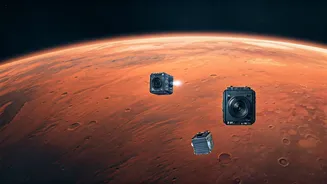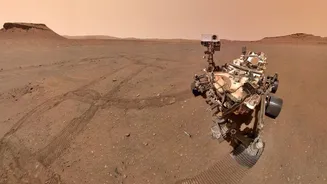ESCAPADE Mission Overview
The Escape and Plasma Acceleration and Dynamics Explorers (ESCAPADE) mission, spearheaded by the University of California, Berkeley, and funded by NASA,
is designed to study Mars's interaction with the solar wind. The mission's primary objective is to investigate the planet's magnetosphere, which is the region influenced by its magnetic field. ESCAPADE employs two identical small satellites, named 'Blue' and 'Red', that will orbit Mars. These satellites work in tandem to create a comprehensive understanding of the Martian environment, including its magnetic field's behavior in response to solar wind activity. The twin satellites' simultaneous observation of the upper atmosphere will enable a 3D view of how the solar wind strips away atmospheric gases. This information is vital for comprehending the evolution of Mars, its past habitability, and potential for future exploration. The mission is an integral part of NASA's broader efforts to understand the red planet and its place in the solar system.
Mission Objectives and Goals
The ESCAPADE mission has clearly defined objectives, primarily focusing on understanding the Martian magnetosphere. One of the principal goals is to determine how the solar wind interacts with Mars's atmosphere. The solar wind, a stream of charged particles emitted by the Sun, constantly bombards Mars. Understanding this interaction is key to deciphering how Mars lost much of its atmosphere over billions of years. By observing how the solar wind influences the planet's upper atmosphere, scientists aim to learn more about the escape processes that lead to atmospheric erosion. The mission will measure the density, temperature, and velocity of plasma in the Martian environment. Data gathered will provide insights into the planet's present state and its atmospheric evolution over time. The mission's success will provide crucial insights into how planets lose their atmospheres and aid in better understanding the factors influencing a planet's ability to support life.
Twin Satellite System
A distinguishing characteristic of the ESCAPADE mission is the utilization of two small satellites. These satellites, known as Blue and Red, are equipped with identical scientific instruments and fly in tandem around Mars. This dual-satellite approach allows for comprehensive measurements of the Martian environment from multiple perspectives. The satellites are designed to gather data simultaneously, generating a 3D picture of the planet's interaction with the solar wind. Their coordinated measurements allow researchers to study how the solar wind affects various altitudes within the Martian atmosphere. The separation of the satellites provides a unique vantage point, enabling the observation of spatial variations in plasma and magnetic fields. The design enhances the ability to map the dynamic processes occurring within Mars's magnetosphere. The data gathered from both satellites will be integrated to create models that explain how the solar wind and Mars's atmosphere interact, contributing to a holistic understanding of the planet's environment.
Scientific Instruments Onboard
Each of the ESCAPADE satellites is outfitted with advanced scientific instruments specifically designed to study Mars's atmosphere and its interaction with the solar wind. These instruments play a crucial role in gathering critical data that helps scientists understand the planet’s environment. A key instrument is the Magnetometer, which measures the strength and direction of the magnetic field surrounding Mars. This instrument gives insight into how the solar wind influences the magnetic environment. Another important instrument is the Ion and Neutral Mass Spectrometer (INMS), which analyzes the composition of the Martian atmosphere. The INMS identifies different types of ions and neutral particles to comprehend how the atmosphere changes over time. Additionally, the mission employs a suite of plasma instruments to measure the density, temperature, and velocity of the plasma. These instruments are vital for studying the dynamics of the plasma interaction. The data acquired from all of the instruments will be combined to construct a comprehensive understanding of Mars's atmospheric processes and solar wind interactions.
Expected Outcomes and Impact
The ESCAPADE mission is poised to provide a wealth of valuable information about the Martian atmosphere and its interaction with the solar wind. One of the main anticipated outcomes is a deeper understanding of the processes that caused Mars to lose its atmosphere. Data gathered will help scientists model how the solar wind strips away atmospheric gases, influencing the planet's evolution. The mission is expected to deliver detailed measurements of the planet's magnetosphere and plasma environment. These measurements are crucial for understanding how the solar wind impacts Mars today and how it might have affected the planet over billions of years. Another significant outcome will be insights into how other planets, including Earth, may be affected by their interaction with solar winds. The data from ESCAPADE will contribute to our understanding of planetary habitability, the conditions required for life to exist, and the challenges faced by planetary atmospheres.












